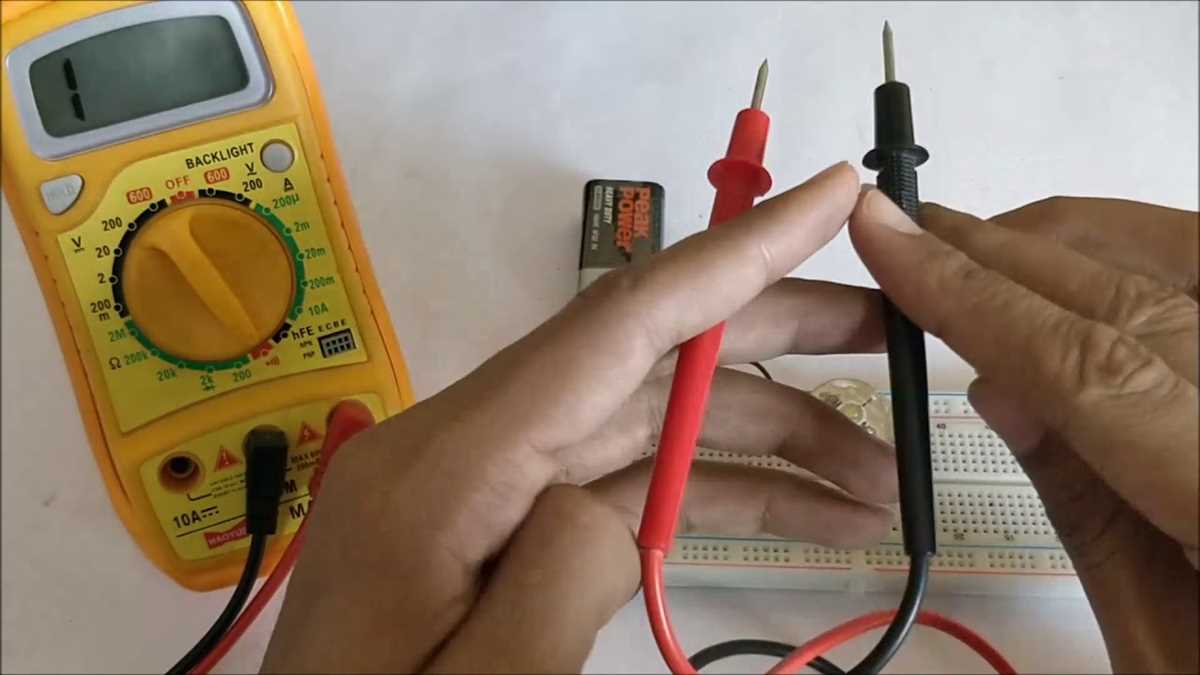
The Mass Air Flow (MAF) sensor is a critical component in the engine management system of a vehicle. It measures the amount of air entering the engine and sends this data to the engine control unit (ECU). A malfunctioning MAF sensor can lead to poor fuel efficiency, rough idling, and engine performance issues. Testing the MAF sensor is an important step in diagnosing and resolving any issues with your vehicle.
Traditionally, testing the MAF sensor would require the use of a multimeter, a handy tool for measuring electrical currents, voltages, and resistances. However, not everyone has access to a multimeter or knows how to use one. Luckily, there are alternative methods to test the MAF sensor without a multimeter.
One way to test the MAF sensor without a multimeter is by using a scan tool or OBD-II diagnostic tool. These tools can read and interpret the data sent by the MAF sensor to the ECU. By accessing the sensor data through the tool, you can check if the MAF sensor is operating within the specified range. If the sensor readings are significantly off, it may indicate a faulty MAF sensor that needs to be replaced.
How to Test MAF Sensor without Multimeter
The Mass Air Flow (MAF) sensor is a critical component in a vehicle’s engine management system. It measures the amount of air entering the engine and provides the necessary feedback for the fuel injection system to deliver the correct amount of fuel. If the MAF sensor is faulty, it can lead to poor engine performance and fuel economy. Testing the MAF sensor is usually done using a multimeter, but there are alternative methods that can be used if a multimeter is not available.
Visual Inspection: The first step in testing the MAF sensor without a multimeter is to visually inspect it for any signs of damage or contamination. Look for any loose connections, broken wires, or dirt/debris on the sensor. Clean the sensor with an appropriate cleaner if necessary.
Testing with a Voltmeter: If you don’t have a multimeter, you can use a voltmeter to test the MAF sensor. Start by disconnecting the sensor from the vehicle’s wiring harness. Set the voltmeter to the voltage range and connect the positive lead to the signal wire and the negative lead to a ground. Have an assistant start the engine and idle it. The voltmeter should show a fluctuating voltage signal between 0.5 and 5 volts. If the voltage signal is steady or outside the normal range, it indicates a faulty MAF sensor.
Using a Scan Tool: Another option is to use a scan tool to test the MAF sensor. Connect the scan tool to the vehicle’s diagnostic port and access the datastream or live data section. Look for the MAF sensor readings, which may be labeled as “MAF” or “MAF G/S” (grams per second). The readings should vary as the engine speed and load changes. If the readings are erratic or not changing, it could indicate a problem with the MAF sensor.
While these methods can provide some insight into the condition of the MAF sensor, it’s important to note that they may not provide a definitive diagnosis. If you suspect a problem with the MAF sensor, it’s recommended to consult a professional mechanic or use a multimeter for more accurate testing.
Visual Inspection

The first step in testing a Mass Air Flow (MAF) sensor without a multimeter is to perform a visual inspection. This involves examining the sensor and its connections for any visible signs of damage or wear. Look for any loose or corroded wires, damaged connectors, or physical damage to the sensor itself. Additionally, check for any dirt or debris that may be obstructing the sensor’s intake or airflow.
If you notice any issues during the visual inspection, such as a damaged wire or connector, it is recommended to fix or replace the faulty component before proceeding with further testing. A damaged or obstructed sensor can result in inaccurate readings and affect the overall performance of the MAF sensor.
Steps:
- Inspect the MAF sensor and its connections for any visible signs of damage or wear.
- Check for loose or corroded wires, damaged connectors, or physical damage to the sensor itself.
- Remove any dirt or debris that may be obstructing the sensor’s intake or airflow.
- If any issues are found, fix or replace the faulty component before proceeding with further testing.
Check for Dirty or Contaminated Sensor

One of the possible reasons for a malfunctioning Mass Air Flow (MAF) sensor is dirt or contamination on the sensor itself. Over time, dust, dirt, and oil particles can accumulate on the sensor, affecting its accuracy and performance. Cleaning the MAF sensor can help resolve issues related to poor air-to-fuel ratio, misfire, rough idling, and reduced engine power.
To check for a dirty or contaminated MAF sensor, you will need to access it. Depending on your vehicle’s make and model, the location of the MAF sensor may vary. Typically, it is located between the air filter housing and the throttle body. Refer to your vehicle’s service manual or consult a professional mechanic for specific instructions on locating and accessing the MAF sensor.
Once you have accessed the MAF sensor, visually inspect it for any visible dirt or contaminants. Look for signs of oil residue, dirt particles, or debris. It is essential to handle the sensor with care, as it is a delicate component. Avoid touching the sensor’s wires or the sensing element directly.
If you notice any dirt or contaminants on the MAF sensor, it can be cleaned using a specialized MAF sensor cleaner. Avoid using general-purpose cleaning agents, as they may damage the sensitive components. Follow the instructions on the cleaner canister for the specific cleaning process. Generally, it involves spraying the cleaner onto the sensor and allowing it to dry. Repeat the process if necessary until the sensor appears clean.
Use a Scan Tool
If you don’t have a multimeter or prefer a more advanced method of testing your MAF sensor, you can use a scan tool. A scan tool is a diagnostic device that connects to your vehicle’s onboard computer system, allowing you to retrieve and analyze data.
To test your MAF sensor with a scan tool, start by connecting the tool to your vehicle’s diagnostic port. This port is usually located under the dashboard on the driver’s side. Once connected, turn on the scan tool and follow the prompts to access the MAF sensor data.
With the scan tool, you can view real-time sensor data, including the readings from the MAF sensor. Look for the MAF sensor data and pay attention to the values, such as the airflow rate and voltage. Compare these values to the specifications provided by the manufacturer to determine if the sensor is functioning properly.
Furthermore, a scan tool may also provide additional diagnostic information, such as trouble codes. If your vehicle’s check engine light is on, you can use the scan tool to retrieve the codes and further troubleshoot the issue.
In conclusion, using a scan tool is an effective way to test your MAF sensor without a multimeter. It allows you to access real-time sensor data and compare it to the manufacturer’s specifications. Additionally, a scan tool can provide further diagnostic information, making it a valuable tool for troubleshooting your vehicle’s issues.
Utilize a Cigarette Lighter Voltage Adapter
If you don’t have a multimeter on hand to test your MAF sensor, you can use a cigarette lighter voltage adapter as an alternative method. This device is designed to plug into your car’s cigarette lighter socket and provide a voltage reading.
To test your MAF sensor, start by plugging the voltage adapter into the cigarette lighter socket. Make sure your car’s ignition is turned on, but the engine is off. Then, locate the MAF sensor in your vehicle. It is typically located between the air filter box and the engine, attached to the intake tube.
Next, disconnect the electrical connector from the MAF sensor. This will allow you to access the pins on the connector. Insert the positive and negative probes of the voltage adapter into the appropriate pins on the connector. Typically, the positive pin is a signal pin and the negative pin is a ground pin. Refer to a vehicle-specific wiring diagram or manual for the exact pinout of your MAF sensor connector.
Once the probes are securely inserted, start your car’s engine and observe the voltage reading on the cigarette lighter voltage adapter. The voltage reading should fluctuate as you rev the engine. If the voltage remains stable or there is no reading at all, it may indicate a faulty MAF sensor. However, it is important to note that the specific voltage values can vary depending on the make and model of your vehicle.
Using a cigarette lighter voltage adapter as a makeshift multimeter can provide a quick and convenient way to test your MAF sensor without the need for specialized tools. However, it is still recommended to use a multimeter for more accurate readings and diagnosis if possible.
Remove the MAF Sensor for Physical Testing
When testing the MAF (Mass Air Flow) sensor without a multimeter, one method is to physically remove the sensor for a visual inspection. This can help identify any visible signs of damage or contamination that may be affecting its performance.
To remove the MAF sensor, start by locating it in the air intake system. It is usually positioned between the air filter box and the throttle body. Refer to the vehicle’s service manual if needed.
Once located, carefully disconnect the electrical connector that is attached to the sensor. This may require pressing on a release tab or squeezing the sides of the connector. Be cautious not to damage the connector or the wires.
Next, remove any screws or clips that are securing the sensor in place. Depending on the vehicle, these may be located on the sensor itself or on the surrounding air intake components. Use the appropriate tools to loosen and remove these fasteners.
Once the sensor is free, inspect it visually for any signs of damage or contamination. Look for dirt, debris, or oil buildup on the sensor element or the electrical connectors. Check for any broken or corroded wires as well.
If any issues are found during the visual inspection, such as a dirty or damaged sensor, it is advisable to clean or replace the MAF sensor. Consult the vehicle’s service manual or a trusted mechanic for guidance on proper cleaning or replacement procedures.
Remember to reassemble the MAF sensor and ensure that it is securely fastened before starting the engine. Physical testing can provide valuable insights into the condition of the MAF sensor and help diagnose any potential issues affecting the vehicle’s performance.
Seek Professional Help
If you have tried all the above methods to test your MAF sensor without a multimeter and are still experiencing issues with your vehicle, it’s time to seek professional help.
A professional mechanic or technician will have the tools, knowledge, and experience to properly diagnose and repair any issues with your MAF sensor. They will be able to conduct a thorough inspection, use the appropriate diagnostic equipment, and accurately identify the problem. By seeking professional help, you can ensure that your vehicle is repaired correctly and that you avoid any further damage or complications.
Remember, attempting to test or repair your MAF sensor without the necessary skills or equipment can potentially cause more harm than good. It’s always best to leave complex electrical and technical repairs to professionals to ensure the safety and reliability of your vehicle.
By following the steps outlined in this article, you can gain a better understanding of the functionality and testing of your MAF sensor. However, if you find yourself unsure or uncomfortable with conducting these tests yourself, it’s recommended to seek professional assistance. The experts will be able to provide the specialized care and attention that your vehicle needs to get back on the road.